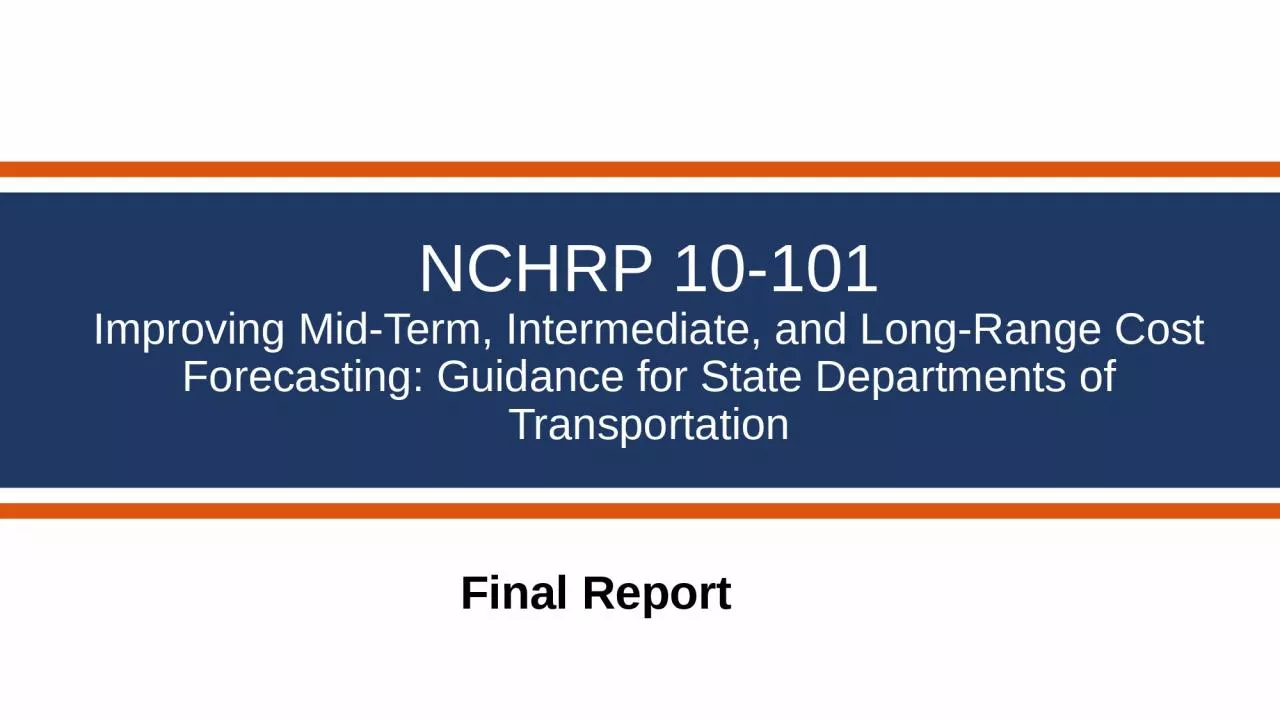

Transportation Final Report NCHRP 10101 Research Team Jorge A Rueda Principal Investigator Auburn University HRC 2 Cliff Schexnayder CoPrincipal Investigator Arizona State University ID: 1028445
Download Presentation The PPT/PDF document "NCHRP 10-101 Improving Mid-Term, Interme..." is the property of its rightful owner. Permission is granted to download and print the materials on this web site for personal, non-commercial use only, and to display it on your personal computer provided you do not modify the materials and that you retain all copyright notices contained in the materials. By downloading content from our website, you accept the terms of this agreement.
1. NCHRP 10-101Improving Mid-Term, Intermediate, and Long-Range Cost Forecasting: Guidance for State Departments of TransportationFinal Report
2. NCHRP 10-101: Research Team Jorge A. Rueda Principal Investigator Auburn University - HRC2Cliff Schexnayder Co-Principal Investigator Arizona State UniversityGhada Gad Co-Principal Investigator Cal Poly PomonaDan D’Angelo Co-Principal Investigator Applied Research AssociatesCesar F. Mayorga Graduate Research Assistant Auburn University
3. Webinar Scope & Associated Products Webinar – Final Report Webinar – Guidebook Cost Forecasting Toolkit3
4. NCHRP 10-101 Project - OverviewScope:Forecasting time horizons:Short-Term: 1 – 2 years → FHWA Report Mid-Term: 3 – 5 yearsIntermediate-Range: up to 15 yearsLong-Range: more than 15 years The study is focused on cost forecasting methods rather than on the estimation of the unforecasted cost estimates. 4
5. Current Typical Cost Forecasting Process5
6. Ideal Cost Forecasting Process6Part 1:Assessment of Cost Indexing AlternativesPart 2:Assessment of Cost Forecasting Approaches
7. Case Studies 7AgenciesCase Study Methodology
8. 8Part 1:Assessment of Cost Indexing Alternatives
9. Existing Cost Indexing AlternativesTraditional Cost Indexing Approach Highway ConstructionFHWA - National Highway Construction Cost Index (NHCCI)MnDOT – Construction Composite Cost IndexCDOT – Colorado Construction Cost IndexBuilding ConstructionRSMeans - Construction Cost IndexMacroeconomic Indexes BLS – Consumer Price Index (CPI)BEA – Personal Consumption Expenditures (PCE) Price Index9
10. Multilevel Construction Cost Index (MCCI)Colorado DOT10Pay Item LevelSub-Division Level 1Sub-Division Level 2Division LevelAgency Level
11. MCCI Divisions - Colorado Division 2 – Earthwork Division 3 – BasesDivision 4 – PavementsDivision 5 – StructuresDivision 6 – Miscellaneous Construction 11
12. 12MCCIs Developed and AssessedGeographic ClassificationIndex InputAwarded Unit PricesAverage Unit Prices per ProjectMedian Unit Price per ProjectAll Unit Prices
13. Colorado:20 MCCI Versions13
14. Top Three Cost Indexing Alternatives per Region14
15. 15Part 2:Assessment of Cost Forecasting Approaches
16. Inflation Rates16
17. Linear and Exponential Regression17
18. Moving Forecasting Error Method18One 19.5-year periodTen 15-year periods10-year periods = 20 Forecasting Errors5-year periods = 30 Forecasting Errors3-year periods = 34 Forecasting ErrorsForecastingError1 ForecastingError10 ForecastingError
19. MFE - Average Forecasting Errors 19Average forecasting errors calculated with less than 10 observations
20. Risk-Based Forecasting Timeline with MFE Results20
21. Major Findings from Data Analysis MCCI are significantly more effective than traditional CCIsStatewide MCCIs tend to outperform regional MCCIsConstruction activities in different locations could be affected by different inflation patternsMCCIs built with awarded unit prices or all unit prices showed a better performance21
22. Major Findings from Data Analysis (Cont.) Transportation construction prices have been increasing on an overall exponential rate during the last 20 years. This means that compounded inflation rates tend to be more suitable for cost forecasting purposes. Significant differences in the use of simple or compounded inflation rates start to appear as the forecasting time horizon extends over more than 5 years. 22
23. Major Findings from Data Analysis (Cont.) A ten-year case study conducted in Minnesota showed that an agency with only ten years of available historical bid data to implement the data-driven forecasting procedures proposed in this report could expect a 40% reduction in forecasting effectiveness with respect to the performance offered by a 20-year dataset.Regression analysis models are more suitable to model the anticipated continuation of short-term abnormal price fluctuations. MFE models could yield a more conservative output opting for a more normal pricing behavior.23
24. Cost Forecasting Approach Selection Framework24
25. Module 1 – Cost Index Selection25
26. 26Module 2 – Standard Inflation Rate Selection
27. Module 3 – Mid-Term Forecasting Method Selection27
28. Module 4 – Intermediate-Range Forecasting Method Selection28
29. Module 5 – Long-Range Forecasting Method Selection29
30. 30The National Cooperative Highway Research Program (NCHRP) produces ready-to-implement solutions to the challenges facing transportation professionals. NCHRP is sponsored by the individual state departments of transportation of the American Association of State Highway and Transportation Officials (AASHTO), in cooperation with the Federal Highway Administration (FHWA). NCHRP is administered by the Transportation Research Board (TRB), part of the National Academies of Sciences, Engineering, and Medicine. Any opinions and conclusions expressed or implied in resulting research products are those of the individuals and organizations who performed the research and are not necessarily those of TRB; the National Academies of Sciences, Engineering, and Medicine; or NCHRP sponsors. For more information, go to:www.TRB.org(type “NCHRP 10-101” in the search tool)Any Questions?Jorge RuedaAssistant Professor Department of Civil Engineering Auburn University Phone: 334-844-3725Email: JRueda@auburn.edu Thank you!